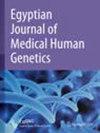一名 TGFBR1 基因突变患者的腹主动脉瘤并发降主动脉夹层
IF 1.2
Q4 GENETICS & HEREDITY
引用次数: 0
摘要
我们描述了一例腹主动脉瘤并发B型胸主动脉夹层的病例,分子分析显示该病例存在致病性TGFBR1错义突变。一名36岁的女性因突发背痛被送入我院。计算机断层扫描血管造影显示降主动脉夹层延伸至腹主动脉瘤。全外显子组测序和随后的桑格测序证实了 TGFBRI 基因的致病突变(NM_004612.4:c.605C > T; p.Ala202Val)。她拒绝接受手术,一个月后死亡。据我们所知,这是第一例记录在案的 TGFBR1 基因突变并发腹主动脉瘤和降主动脉夹层的病例。她的迅速死亡强调了及时干预 TGFBR1 基因突变阳性患者的重要性。本文章由计算机程序翻译,如有差异,请以英文原文为准。
Abdominal aortic aneurysm complicated by descending thoracic aortic dissection in a patient with TGFBR1 mutation
We described a case of abdominal aortic aneurysm complicated by type B thoracic aortic dissection, in whom molecular analysis revealed a pathogenic TGFBR1 missense mutation. A 36-year-old woman was admitted to our hospital with sudden onset of back pain. Computed tomography angiogram demonstrated descending aortic dissection extending into the abdominal aorta aneurysm. Whole-exome sequencing and subsequent Sanger sequencing confirmed a pathogenic mutation in the TGFBRI gene (NM_004612.4: c.605C > T; p.Ala202Val). She refused to receive surgery and died one month later. To our knowledge, this is the first documented case of the TGFBR1 gene mutation who suffered from abdominal aortic aneurysm complicated by descending thoracic aortic dissection. Her rapid death underscores the importance of timely intervention in TGFBR1 mutation-positive patients.
求助全文
通过发布文献求助,成功后即可免费获取论文全文。
去求助
来源期刊

Egyptian Journal of Medical Human Genetics
Medicine-Genetics (clinical)
CiteScore
2.20
自引率
7.70%
发文量
150
审稿时长
18 weeks
 求助内容:
求助内容: 应助结果提醒方式:
应助结果提醒方式:


